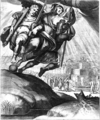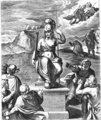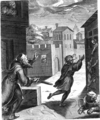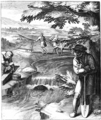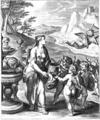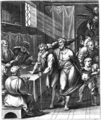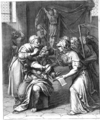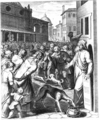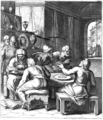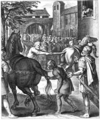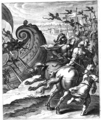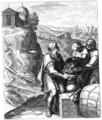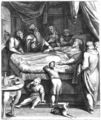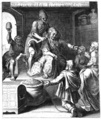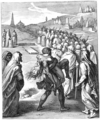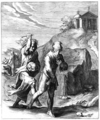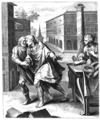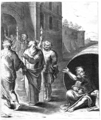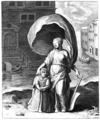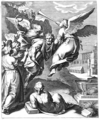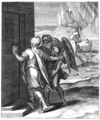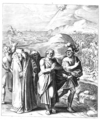Introduction
This is our edition of Q. Horatii Flacci Emblemata of 1612. In this introduction, we have limited ourselves to the essentials.
About Otto Vaenius
Otto Vaenius (or Otto van Veen) was trained as a painter and humanist.1 He was born in Leiden in 1556. In 1572, because of the political situation, he fled to the southern Netherlands with his family. In Liege he studied for a few years under Dominicus Lampsonius, and then left for a five-year stay in Italy. After his return to the southern Netherlands he stayed in Liege, Brussels and then settled in Antwerp. In all of these locations, Vaenius always tried to maintain favour with the Court. Until the return of his pupil Rubens from Italy, Vaenius was the leading painter in Antwerp. In his later years he turned to producing emblem books, notably Q. Horatii Flacci emblemata (1607), Amorum emblemata and Amoris divini emblemata. In 1612 he was appointed Master of the Archducal Mint. He moved to Brussels in 1615, where he died in 1629.
About the Q. Horatii Flacci emblemata
Q. Horatii Flacci emblemata was first published in 1607.2 Two separate editions were printed that same year. The first of these contained only Latin texts from classical authors (mainly Horace) with a facing-page allegorical engraving. In this form, the book does not bear any resemblances with the Alciatian emblem. Vaenius himself presented it as a collection of 'emblemata', using the word as a synonym for 'sententiae'. Later that year, a second edition of Q. Horatii Flacci emblemata was brought out by the same publisher, Jerome Verdussen. This time the Latin texts were accompanied by Dutch and French quatrains, and the collection of texts and pictures then started to look like emblems. In the third edition of 1612 Spanish and Itailan verses were added.
In the preface to the third edition (which we have chosen to digitise), Vaenius wrote the following about the purpose of the additional texts: 'Now, in order to make the [=the original engravings and texts] to see and read, it has seemed appropriate to explain these emblems in several languages' (see: Lectori seu spectatori). The Dutch verses of 1607 were made by Gerbrand Adriaansz. Bredero. In 1612 they were replaced by verses of an unknown author. The French verses of 1607 were also partly replaced by new ones made by Leo de Meyer. The book as a whole is the product of the collaboration of many artists. On basis of the preparatory sketches for the book that have survived, the co-work between Vaenius and the engravers have been studied. The Q. Horatii Flacci emblemata was a joined effort of printers, learned commentators on Horace, engravers and Vaenius himself, as the poet explains in Cuiqve suum studium. [70] of the book.
The implied audiences for these earlier and later editions must have been different. The book, in all its editions, leant itself to many purposes in a variety of different cultures and countries. It was circulated widely during the seventeenth and eighteenth century, as it was copied and pirated in France, Spain, Italy and England. A new edition in Dutch, in which the original texts were completely revised by Anthony Janssen van der Goes (ca. 1626-1699), appeared in Amsterdam in 1683.3
The Q. Horatii Flacci emblemata was used for the instruction of a future king in France, and used as a pictorial-source book for the decoration of interiors. And yet, it has so far not been looked at as the emblem book that marked the beginning of the popularity of the love emblem in the Netherlands. Yet it is clearly the predecessor of Vaenius's own Amorum emblemata (see: Anders: ), and it probably influenced other authors besides Vaenius as well.
Copy Used for This Edition
In making this edition of Q. Horatii Flacci emblemata we have used the copy of the edition of 1612 conserved in the Library of the Utrecht University, shelf number LBKUN RAR LMY VEEN, O 4.
Transcription
We have transcribed the full text from the Utrecht copy and encoded this text using TEI mark-up, to allow for flexibility in presentation and non-destructive editorial enhancement of the text. The full Project Guidelines for transcription, editorial intervention and indexing of the text are available elsewhere on this site.
Literature
The full Emblem Project Utrecht bibliography may be accessed using the menu option at the left side of this (or any) window. A selection of literature relevant to Q. Horatii Flacci Emblemata follows here.
Notes

 and Gerards-Nelissen, Otto van Veen
and Gerards-Nelissen, Otto van Veen and
Thøfner, Making a Chimera
and
Thøfner, Making a Chimera and Adams, Rawles and Saunders, Bibliography
and Adams, Rawles and Saunders, Bibliography
![[H O M E : Emblem Project Utrecht]](/static/images/rd-small.gif)







